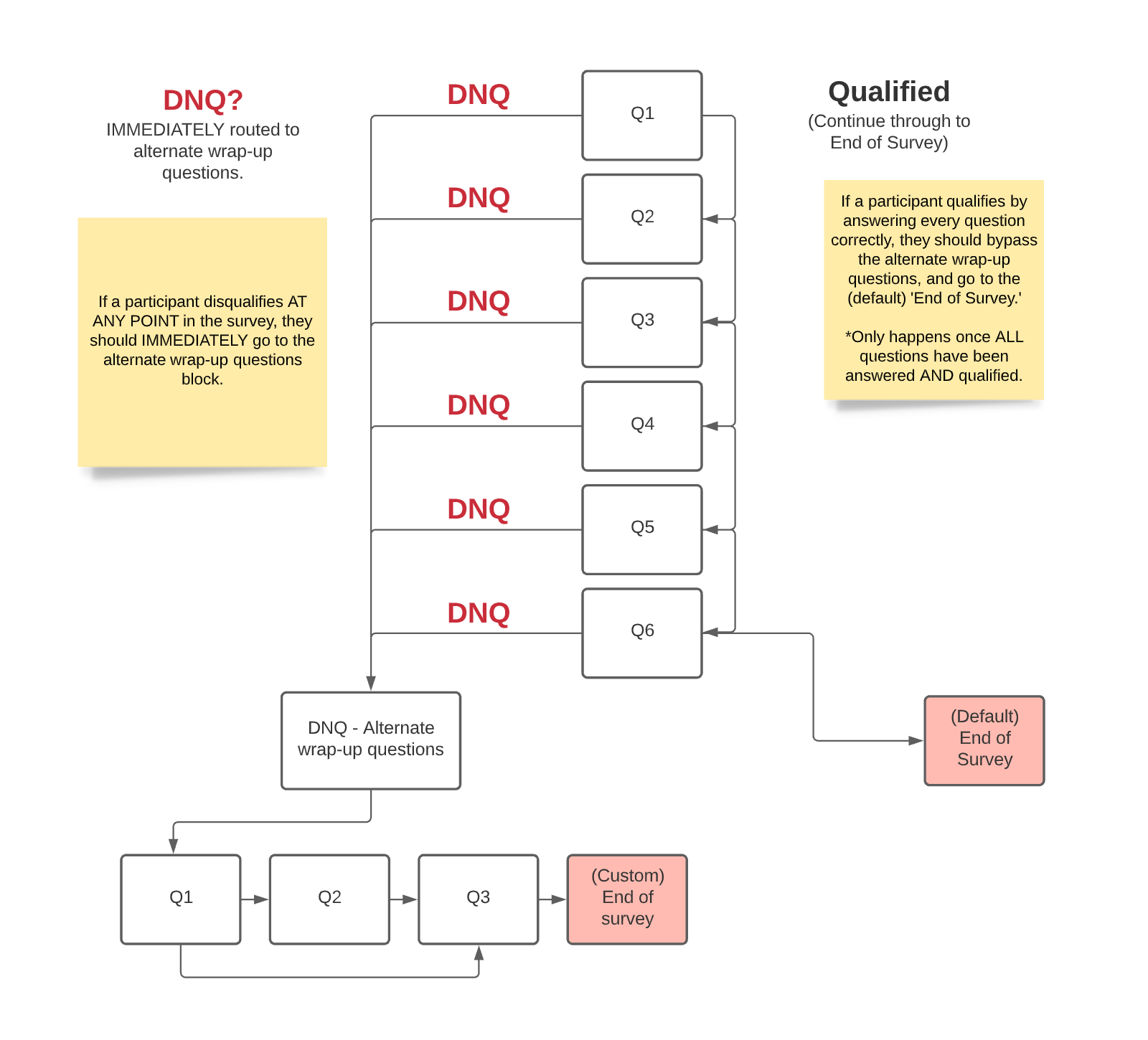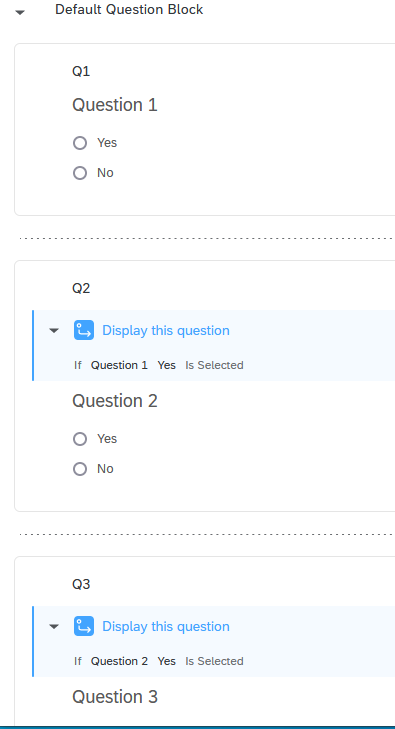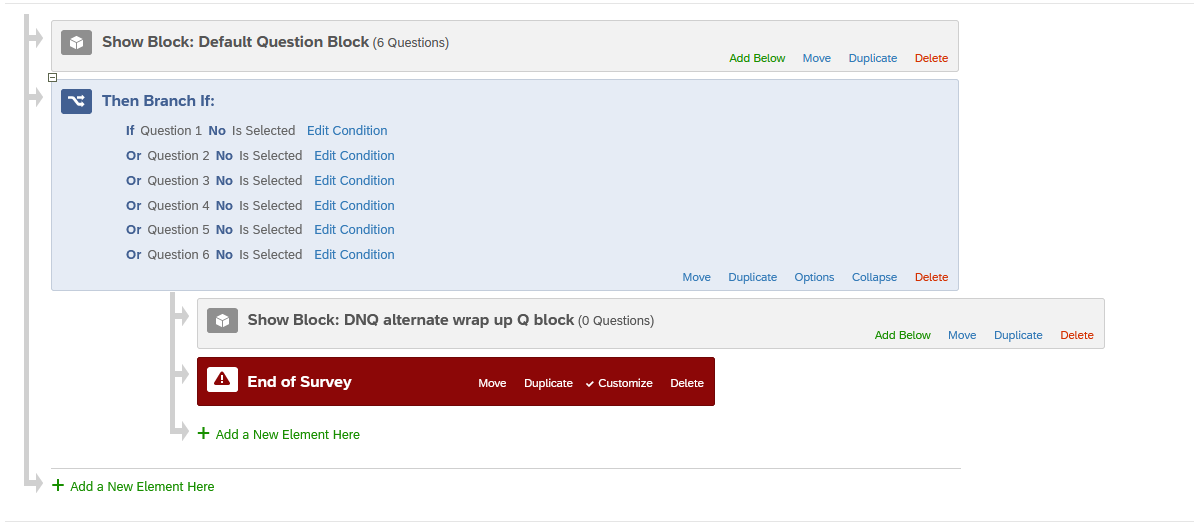I am creating several pre-screeners/questionnaires that will determine eligibility based on conditional logic.
Not qualified?
When a person is not qualified (based on any given answer in the questionnaire), I would like to immediately send them to a specific set of questions right before ending the survey. Basically, these would be wrap-up questions for those who DNQ.
Qualified
If they are qualified, I would like for them to go to the default end of survey (with no additional questions).
An example of questions (for those who didn't qualify) in this block would be...
Sorry you didn't qualify. Would it be okay if we still keep your info on file anyway?
Yes|No
Yes = go to end of survey
No = Go to custom end of survey
This seems like it should be easy, yet I'm running into limitations...
Skip logic only allows me to skip to the next block, or to the default end, but not to a specific block of my choosing. As a result, I've created a complicated nest of Branch logic that has to be repeated over and over again for each eligibility question.
What I would like to have happen is, when a person has DNQ'd, they would skip to a specific block of questions positioned right before the default End of Survey.
If they never DNQ throughout the survey, they would just finish out the survey and arrive at the default End of Survey.
Any advice on how to best design this?
Thanks!
Add a block of questions right before End of Survey; skip to them only if/when participant has DNQ'd
Sign up
Already have an account? Login

Welcome! To join the Qualtrics Experience Community, log in with your existing Qualtrics credentials below.
Confirm your username, share a bit about yourself, Once your account has been approved by our admins then you're ready to explore and connect .
Free trial account? No problem. Log in with your trial credentials to join.
No free trial account? No problem! Register here
Already a member? Hi and welcome back! We're glad you're here 🙂
You will see the Qualtrics login page briefly before being taken to the Experience Community
Login with Qualtrics

Welcome! To join the Qualtrics Experience Community, log in with your existing Qualtrics credentials below.
Confirm your username, share a bit about yourself, Once your account has been approved by our admins then you're ready to explore and connect .
Free trial account? No problem. Log in with your trial credentials to join. No free trial account? No problem! Register here
Already a member? Hi and welcome back! We're glad you're here 🙂
You will see the Qualtrics login page briefly before being taken to the Experience Community
Login to the Community

Welcome! To join the Qualtrics Experience Community, log in with your existing Qualtrics credentials below.
Confirm your username, share a bit about yourself, Once your account has been approved by our admins then you're ready to explore and connect .
Free trial account? No problem. Log in with your trial credentials to join.
No free trial account? No problem! Register here
Already a member? Hi and welcome back! We're glad you're here 🙂
You will see the Qualtrics login page briefly before being taken to the Experience Community
Login with Qualtrics

Welcome! To join the Qualtrics Experience Community, log in with your existing Qualtrics credentials below.
Confirm your username, share a bit about yourself, Once your account has been approved by our admins then you're ready to explore and connect .
Free trial account? No problem. Log in with your trial credentials to join. No free trial account? No problem! Register here
Already a member? Hi and welcome back! We're glad you're here 🙂
You will see the Qualtrics login page briefly before being taken to the Experience Community
Enter your E-mail address. We'll send you an e-mail with instructions to reset your password.







 And here is how the Survey Flow would be set up. The DNQ wrap-up questions are in a separate block, and that block only appears if No is selected in any of Q1-Q6, followed by the custom EOS object. If Yes is selected for all Q1-Q6, the respondents will "skip" the DNQ block and see the default EOS message.
And here is how the Survey Flow would be set up. The DNQ wrap-up questions are in a separate block, and that block only appears if No is selected in any of Q1-Q6, followed by the custom EOS object. If Yes is selected for all Q1-Q6, the respondents will "skip" the DNQ block and see the default EOS message.

